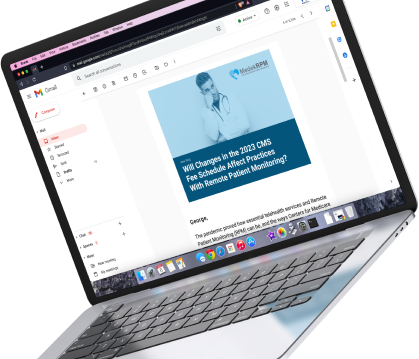
Make no mistake, Healthcare providers are investing in Remote Patient Monitoring (RPM) solutions. Beginning in 2020, changes to RPM CPT® codes, made Remote Patient Monitoring, as an industry, an attractive patient solution. There are benefits to patients including, increased patient safety, ease in using, and the reduction in transportation costs. Changes with of government spending made RPM attractive, for doctors to use RPM as a solution. MedekRPM provides RPM devices to your patients at no cost to your practice. Using MedekRPM means your patients will receive free Remote Patient Monitoring medical devices.
A Change in Protocol
For the government, it made practical and financial sense to guide patients towards a remote monitoring solution. One way RPM makes financial sense is that it has reduced hospital readmissions by 78%. It also improved patient outcomes by 13%. Those improvements mean huge savings across the board. The conventional patient-doctor protocol required patients to make an appointment or drop by within set clinic hours to consult their doctor or capture a health attribute (ie blood pressure, weight, etc.). With RPM, healthcare professionals can gain information about a patient’s health while the patient is at home. More information means better healthcare.
Going into the doctor’s office requires time, transportation efforts and financial costs to patients. This provides no incentive to make multiple visits. This creates few data points for understanding a patient’s health trends. So, patients only return to the doctor’s office when a problem has reached its peak. With Remote Patient Monitoring, doctors receive daily data about their patients. This way, the doctor can address problems before they become advanced.
MedekRPM Remote Patient Monitoring solutions have the potential to prevent serious health issues. With RPM, doctors can know health trends in advance. RPM solutions have been effective as early symptom management tools. RPM can help reduce liability to clinics and hospitals, who have patients who suffer from chronic health conditions.
Benefits of RPM
There is a report from Spyglass Consulting Group named “Trends in Remote Patient Monitoring 2019”. It presents the following advantages for users:
They help manage or control the costs of healthcare.
They improve the quality of healthcare delivery.
They increase healthcare access, especially for under-served areas.
These are some of the benefits of Remote Patient Monitoring according to a Klas Research Study.
* Patient overall health improved by 13%.
* Hospital readmissions fell by a staggering 72%. This leads to healthier patients and improved MIPS scores for providers.
* Providers also reported a 17% reduction in quantified costs.
* There was a 25% increase in patient satisfaction overall.
There are additional financial benefits to medical practices and providers that were not presented in the Klas Study.
Providers Financial Benefits for Remote Patient Monitoring
Patient care is always top of mind, but as most medical practices understand the need to take care of the bottom line. CMS allowed for a complete rewrite and additions to the existing RPM codes. These changes will help the finances of medical practices and providers.
The new codes allow for an extra $120-$220 in billing per patient, per month. This could be a great deal of money for a medical practice with a large population of medicare patients with chronic conditions. Having monthly billing can mean a more consistent revenue plan for the medical practice.
For a medical practice that has Medicare patients, the benefits of RPM can be very large. Both the patient and the provider receive huge benefits, making RPM a needed tool for most medical practices.
Stakeholder Support
Federal, clinical and financial stakeholders have seen the benefits of RPM. Quoting a Research And Markets report, “the RPM equipment market segment is projected to grow to as much as $2.7 billion by 2022—a significant jump from $1.5 billion in 2018”. The software and provider aspects of RPM are expected to expand to a greater extent. Fewer hospital readmissions and fewer emergency room visits make for less expensive healthcare.
RPM offers patients a convenient way for their doctors to monitor them for better healthcare from their homes.
Remote Patient Monitoring can provide a new healthcare tools for chronic care management. This will benefit patients and providers.





